This March, to celebrate the release of Captain America: The Winter Soldier, we’ll be taking a look at some classic and not-so-classic Avengers comic books. Check back daily for the latest updates!
Warren Ellis and Mike Deodato Jr.’s year-long twelve-issue run on Thunderbolts is a phenomenal piece of work from a mainstream comic book company. It’s an absurdly fun comic book – one that goes completely off the rails any number of times, moving with momentum of a runaway freight train. Ellis’ unhinged plotting and dialogue find a perfect partner in Deodato’s dark and moody (yet photo-realistic) artwork.
While Ellis includes quite a bit of social, political and even meta commentary in this year-long anti-hero team-up book, there’s a sense that Thunderbolts was written with an intention of going completely overboard, basking in the surreal absurdity of superhero storytelling conventions while playing with a selection of (mostly) second-tier characters that free Ellis’ hand significantly. There are few dependencies and obligations that Ellis has with this cast, allowing him to go to town with them.
In many respects, Thunderbolts feels like a slightly more cynical, slightly more grounded counterpart to his (roughly) contemporaneous Nextwave: Agents of H.A.T.E. Over course, “slightly more grounded” simply means that a middle-aged civil servant in a goblin outfit is the villain of the piece, rather than a hyper-intelligent talking dinosaur.
There is very obviously a political subtext to Ellis’ Thunderbolts. There can’t help but be. After all, this twelve-issue run unfolds in the context of the grand sweeping narrative of the shared Marvel Universe. Spinning out of the events of Civil War, there’s no way that the book can’t become a vehicle for post-9/11 political commentary. Mark Millar and Brian Michael Bendis had largely pushed the grand arc of Marvel continuity into a grim exploration of post-9/11 cynicism – a world where heroes weren’t necessarily heroes and lawful authority was not a guarantee of basic decency or efficiency.
That said, Ellis is significantly better at this sort of social commentary than many of his contemporaries, if only because he seems to realise that there’s only so far you can stretch “superheroes as a metaphor for American foreign policy” and because he has a wealth of experience in the area. Virtually every comic book trying to insert superheroes into the context of late twentieth century and early twenty-first century politics owes a debt to Ellis’ collaboration with Bryan Hitch on The Authority.
Along with Mark Millar and Hitch’s work on The Ultimates, itself heavily influenced by The Authority, Ellis seemed to set the tone for comics into the twenty-first century. It is no exaggeration to suggest that pretty much every major creator working in the field has been influenced by Ellis. This makes Ellis’ nonchalance about the whole thing seem especially hilarious. Yes, there’s a social and political subtext to Thunderbolts, but it’s very much secondary to a comic about sociopaths in costumes doing mean things to one another.
On the surface, Thunderbolts seems like a very cynical piece of work. It is, after all, about Norman Osborn trying to leverage his political power base and cement his position of authority. For the most part, despite numerous errors and mistakes and bad judgement calls, it seems impossible to dislodge Osborn. At every turn, Osborn seems able to paint a catastrophic failure as some vital success in a long-running campaign. There are good and decent people around – even involved in the programme – but Osborn endures.
This is a comic that – in many ways – seems to hark back to the anti-hero excesses of the nineties. Swordsman has his dead sister’s skin fashioned into the hilt of his sword, with various none-too-subtle insinuations about their familial relationship. When he claims that he loved his sister, Norman deadpans, “I’m sure you did. In many ways.” Venom has reacquired his taste for human flesh (and brains in particular), building off the excesses of the character’s nineties persona.
And yet there’s a charming self-awareness to all this, as Ellis gleefully plays into all these absurd tropes and conventions. Norman Osborn himself draws attention to the absurdity of J. Michael Straczynski’s plot for Sins Past. The Green Goblin seems aware of his own greatest hits, basking in his deliciously one-note villainy. “I should have thrown you off a bridge the moment I laid eyes on you, Songbird,” he remarks at the climax of the run, referencing one of the character’s most infamous in-comic-book moments.
One of the book’s recurring gags presents the Thunderbolts as action figures that can be easily marketed and sold. Debating whether to keep Songbird on the team, Osborn reflects, “I’m told you’re also quite toyetic.” There’s a sense that Ellis is having a great deal of fun throwing these toys together and watching sparks fly – the Thunderbolts all but collapse into a bloody sweaty mess at the end of the run, with Bullseye managing to accidentally save the day without even intending to.
That would seem to be one of the recurring themes of Ellis’ run. Despite the emphasis placed on these characters, despite the legacy of comics like Watchmen or Miracleman or even The Authority, these are still very much goofy comic book characters. Towards the start and end of the run, Osborn identifies himself as a deity, reflecting one of the more tried-and-tested tools of deconstruction in superhero comics – alluding to the old superheroes-as-modern-gods school of thought. “I am the closest thing to God you are ever likely to meet,” he warns Bullseye. Later, he boasts to Swordsman, “I am God.”
Of course, Norman Osborn is not God. He’s just a very naughty boy – a mentally unhinged man who kills quite a few people during a psychological meltdown, but who has his status quo reset at the end of the run. Ellis reiterates time and time again that Thunderbolts is really just a standard superhero comic book. It’s not a philosophical treatise or a political manuscript, or a deconstruction of the genre as a whole.
Indeed, it seems to be Ellis reinforcing the superhero genre as something that can (and will) stand on its own terms. The run begins and ends with Bullseye asserting his own one-dimensional-ness. “What’s your name?” Norman asks him during their “initial interview.” “Bullseye.” Norman repeats, “I’m sorry. I meant your real name.” Bullseye replies. “Bullseye.” That’s what Bullseye is. Nothing more, nothing less. At then end, the telepaths wreaking havoc on the base wonder why they can’t read his mind. “Maybe because I’m Bullseye and you’re just a breathing target,” he calmly suggests.
The implication is that Bullseye is a very simple figure. He’s a supervillain – a nut in a costume who kills people because that’s what we expect from a nut in a costume. There’s only a certain level of complexity you can reach with a character like that. Don’t get me wrong, you can have a lot of fun with a character like that – as Ellis demonstrates throughout his Thunderbolts run. However, not every character is going to multi-faceted and complex and genre-redefining. Sometimes they are just people in silly costumes, and that’s okay.
This might seem pretty cynical. Indeed, Ellis is very good at writing work that appears superficially cynical. After all, it’s worth noting that Thunderbolts is set in a world where Norman Osborn is a power to be reckoned with, but also where all the heroes are dysfunctional at best and selfish at worst. Most of the self-styled “heroes” of Thunderbolts – those standing up to Osborn and his Thunderbolts – are portrayed in a critical light.
When C-list superhero Jack Flag refuses to surrender his costume, he claims that he is fighting for liberty and democracy. His girlfriend, Lucy, is less than convinced. “Is that it?” she asks. “It is, isn’t it? You think your precious Cap’s going to turn up and make you his buddy again. Five bucks says he doesn’t even remember your -“ While Jack Flag evades these accusations, he never explicitly denies them.
A second-tier Spider-Man knock-off, Oliver Osnick is portrayed as disconnected and in need of serious help – his attempts to play the hero land several minor street thugs in hospital, almost cause a race riot and land him in severe personal debt. He winds up charging his super-tech to his parents’ account. And he is fooling nobody. “For God’s sake, Oliver,” his father appeals. “I’m not an idiot. I know what you’re doing.”
These are characters who wind up forcing the Thunderbolts into high-profile public confrontations that put innocent by-standers at risk. As Ellis points out, these are also very white guys who are claiming that their position of social privilege has come under attack. As Native American superhero American Eagle points out, “You do not want to sound too entitled right now.” (During the confrontation with Osnick, it’s telling that the only characters who come out of the issue looking at all sympathetic are the non-white men – Radioactive Man and American Eagle – and some female characters – Songbird and Sepulchre.)
And yet, despite that, there’s a sense that Ellis is still a little fond of good-old-fashioned superheroes, even if the genre conventions do need a little criticism and introspection. American Eagle and Spulchre seem like decent sorts. And then there’s the series’ thematic counterpoint to Bullseye. If Bullseye is a one-dimensional supervillain who works so well because he basks in his own simplicity, then Ellis suggests that Speedball is a heroic counterpoint.
Speedball is a one-dimensional superhero whose primary appeal lies in his simplicity. Like Bullseye, Speedball’s implicity renders him immune to telepathy. “We found out back in the new Warrior days that telepaths don’t really work on me, dunno why.” When the events of Civil War force Speedball to resort to self-mutilation and self-harm, Radioactive Man reflects, “He’s a broken toy, forced to live in a world he was never meant for.”
After all, trying to reimagine a character like Speedball as a “darker and edgier” deconstruction defeats the entire point of the character. Reflecting on an earlier encounter with Speedball, Doc Samson recalls that he asked how the young hero could be so upbeat all the time. Speedball replied, “Doc, I try to find the fun in everything. Otherwise, why even bother?” One can imagine a writer looking at the seriousness of mainstream superhero comics in the wake of 9/11 and thinking the same thing.
This feels like Ellis rejecting all the dour seriousness and self-importance that crept into mainstream comic books in the wake of successes like The Dark Knight Returns or Watchmen. It is fun to deconstruct and to pick apart conventional superhero narratives – it’s interesting to look at the subtext and the meaning, and how it reflects on contemporary society. However, sometimes it is okay to bask in the tropes and conventions of the superhero story, as Ellis does here.
As Doc Samson reflects, Samson, “See, if a knight isn’t in shining armour, then he’s just some scary guy with a big sword.” It’s nice to dress up these scary ideas in colourful outfits and watch them do absurd and goofy stuff. Yes, the existence of somebody like Radioactive Man would have a profound effect on the real world, but these comics aren’t set in the real world. If you take apart these costumed characters too much, if you peel back too many of the layers, the results will be terrifying.
In a way, this explains why Ellis’ run on Thunderbolts became so popular, with Brian Michael Bendis appropriating many of the characters and themes (and even artist Mike Deodato) for his wonderful run on Dark Avengers. Of course, Dark Avengers is considerably less absurd and surreal than portions of Thunderbolts, but there’s an obvious sense that Bendis is building on what Ellis established here.
Interestingly, one of those themes is the idea of hiding something very sinister and very inept behind some canny marketing. Thunderbolts is preoccupied with the idea of image management. Osborn is quite happy to crank out toys based on his team, while he and Moonstone are both very effective at crafting narratives that excuse or disguise their own poor judgement or sociopathic tendencies.
“All that matters are politics, psychology, and ratings,” Moonstone assures Songbird at one point, and she appears to be right. Osborn has created a team of villains who are essentially able to masquerade as heroes through clever branding and promotion. The news coverage and the adoring public have no idea that the floating prison convey used to detain captured rogue superheroes is also used to keep the team locked down during transport to the site.
This idea of image maintenance even bleeds into the team itself. The Chinese government is able to ensure that Radioactive Man is treated with respect – he isn’t placed in shackles and he moves freely without a guard supervising him. Oddly enough, Radioactive Man would much rather have those touches present, if only for appearances. “I wish you would send the guards with me,” he tells Osborn. “It looks bad. To my fellow team members.”
While Thunderbolts is too preoccupied having a great time to really dig into political commentary or social subtext, Ellis still finds any number of opportunities to make none-too-subtle jabs at American pop culture. There are times when Ellis seems to come close to biting the hand that feeds, with Osborn’s preoccupation on marketing his little figures and an advertisement for “Who Wants to be a Thunderbolt?”
Some of these touches are a little heavy-handed. We occasionally cut to news coverage from “Fix News”, boasting the slogan “Giving you your opinion.” Others seem quite sly, like the notion that George W. Bush shares some sympathy with Norman Osborn due to his own somewhat troubled personal history. None of this is particularly subtle, but then again this is a comic about super-powered bad guys posing as would-be superheroes.
There are points where Ellis seems downright subversive, like a conversation between Osborn and Radioactive Man, where Osborn reflects on the irony of an all-American team relying on Chinese muscle. Radioactive Man finds this quite amusing, and the whole conversation could be read as Ellis teasing about the amount of American debt that is owed to China. Despite the common perception of foreign policy rivals, the relationship is a lot more complex than it might seem.
Of course, that’s not the main attraction of Thunderbolts. The main appeal of the book is watching Ellis and Deodato have a great deal of fun with these larger-than-life characters in decidedly over-the-top situations. “Note to self,” Norman Osborn observes at one point, “give naked dictation more often. The ideas seem to flow more freely.” That’s not even close to the craziest thing about Thunderbolts, a comic that finds time for Doc Samson to extol the virtues of Rugby or for Swordsman to reflect on wage inequality in the world of superhero management.
Special mention must be made of artist Mike Deodato. Deodato is an artist who has a wonderful ability to keep to a monthly schedule in an era of comics where that is becoming a much rarer gift. He’s also phenomenally talented. His artwork has developed considerably in the past decade, to the point where he perfectly blends photorealism with more moody and stylised work – he crafts a macabre superhero world that seems to be inhabited by real people. He also has a wonderful sense of pacing – he’s perfectly suited to time and carry off Ellis’ more wry gags, as well as illustrating some beautiful action scenes.
Thunderbolts is a twelve-issue joy, and an absolute pleasure.
Filed under: Comics | Tagged: Anti-hero, avengers, Civil War, Comics, daredevil, green goblin, marvel, mike deodato, mike deodato jr, norman osborn, speedball, thunderbolts, warren ellis |















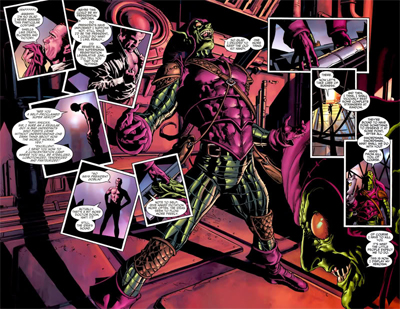
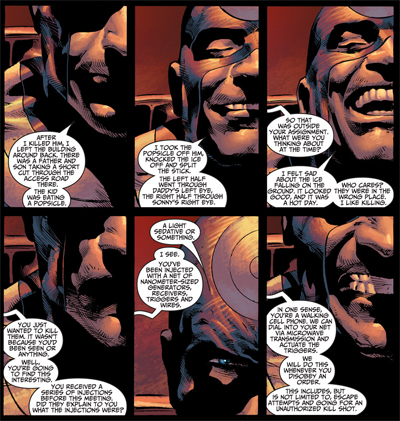
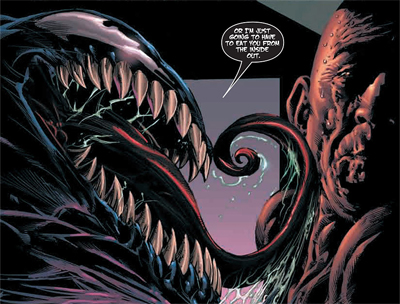
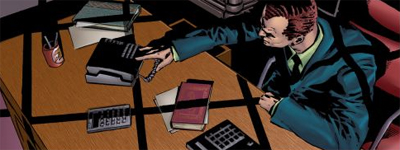


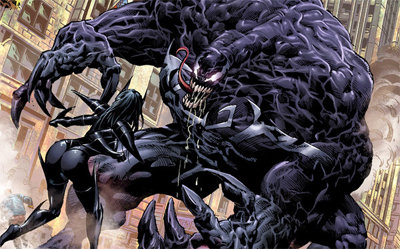
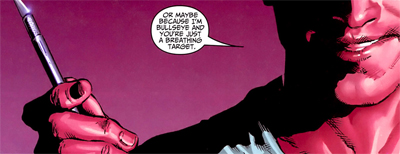

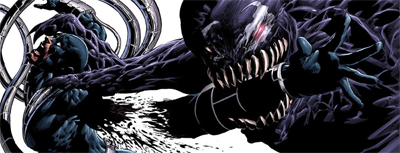
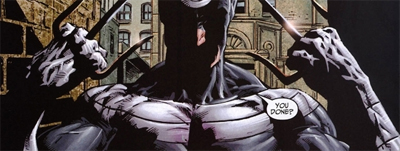

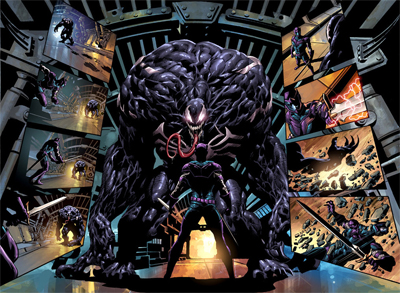

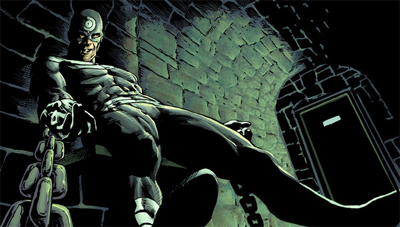





Leave a comment